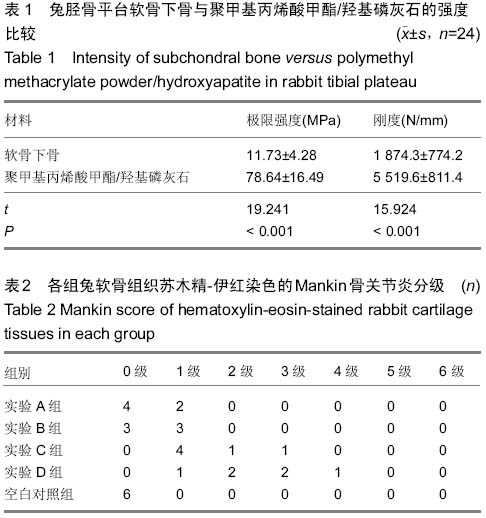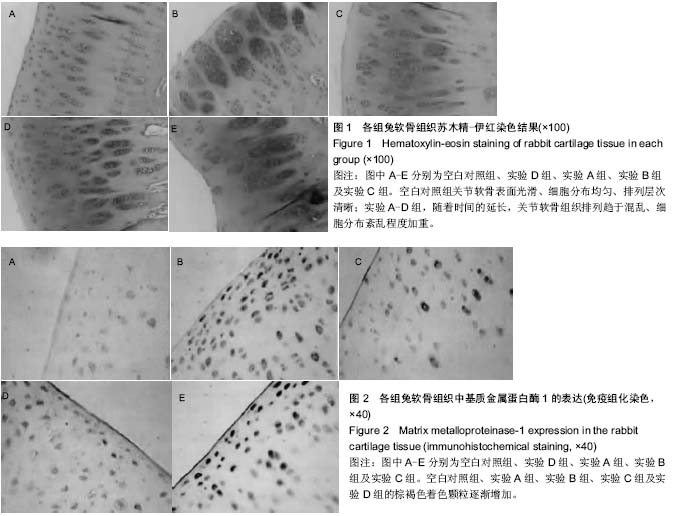中国组织工程研究 ›› 2015, Vol. 19 ›› Issue (25): 3962-3966.doi: 10.3969/j.issn.2095-4344.2015.25.006
• 组织工程骨及软骨材料 tissue-engineered bone and cartilage materials • 上一篇 下一篇
丙烯酸树脂骨水泥复合材料对软骨下骨诱发膝骨关节炎的影响
蒋 华1,颜 宇2,马红兵1,徐 兵1,王俊瑞1,蒋电明3
- 1成都市第二人民医院骨科,四川省成都市 610016;
2四川大学华西医院骨科,四川省成都市 610000;
3重庆医科大学附属第一医院骨科,重庆市 400042
Acrylic resin bone cement composite as a bone substitute for subchondral bone induces knee joint osteoarthritis
Jiang Hua1, Yan Yu2, Ma Hong-bing1, Xu Bing1, Wang Jun-rui1, Jiang Dian-ming3
- 1Department of Orthopedics, Chengdu Second People’s Hospital, Chengdu 610016, Sichuan Province, China;
2Department of Orthopedics, West China Hospital, Sichuan University, Chengdu 610016, Sichuan Province, China;
3the First Affiliated Hospital of Chongqing Medical University, Chongqing 400042, China
摘要:
背景:丙烯酸树脂骨水泥植入人体发生硬化后其可抵抗78-93 MPa的强度,但骨水泥凝固过程中释放大量的热能,会杀死正常细胞导致周围组织坏死。 目的:观察丙烯酸树脂骨水泥复合材料替代软骨下骨后诱发兔膝骨关节炎的特点。 方法:将30只日本大耳白兔随机均分为5组,实验A、B、C、D组在刮除右侧膝关节胫骨平台内侧软骨下骨后,均植入聚甲基丙烯酸甲酯粉剂/羟基磷灰石复合材料,空白对照组仅暴露左侧膝关节胫骨平台内侧骨膜。实验组A、B、C、D组分别在软骨下骨刮除后3,6,9,12周处死动物,切取复合材料上方1.5 mm处的软骨下骨标本进行苏木精-伊红染色、基质金属蛋白酶表达分析,同时检测关节液中白细胞介素1β及肿瘤坏死因子α水水平。 结果与结论:实验C组的Mankin骨关节炎分级高于空白对照组和实验A组(P < 0.05),实验组D的Mankin骨关节炎分级高于实验B组(P < 0.05)。基质金属蛋白酶1的灰度值比较:空白对照组> 实验A组> 实验B组>实验C组> 实验D组(P < 0.05)。白细胞介素1 β及肿瘤坏死因子α水平比较:实验D组> 实验C组> 实验B组> 实验A组> 空白对照组(P < 0.05)。表明丙烯酸树脂骨水泥复合材料替代软骨下骨后能引发膝骨关节炎,并且会导致基质金属蛋白酶1及细胞因子水平的升高。 中国组织工程研究杂志出版内容重点:生物材料;骨生物材料; 口腔生物材料; 纳米材料; 缓释材料; 材料相容性;组织工程
中图分类号:


